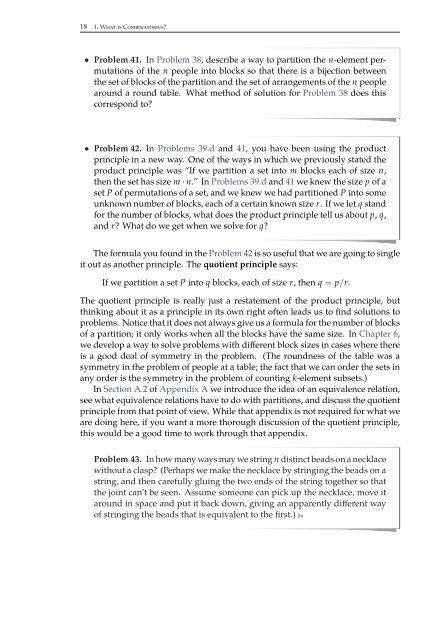Combinatorics Through Guided Discovery, 2004a
Combinatorics Through Guided Discovery, 2004a
Combinatorics Through Guided Discovery, 2004a
You also want an ePaper? Increase the reach of your titles
YUMPU automatically turns print PDFs into web optimized ePapers that Google loves.
18 1. What is <strong>Combinatorics</strong>?<br />
• Problem 41. In Problem 38, describe a way to partition the n-element permutations<br />
of the n people into blocks so that there is a bijection between<br />
the set of blocks of the partition and the set of arrangements of the n people<br />
around a round table. What method of solution for Problem 38 does this<br />
correspond to?<br />
• Problem 42. In Problems 39.d and 41, you have been using the product<br />
principle in a new way. One of the ways in which we previously stated the<br />
product principle was “If we partition a set into m blocks each of size n,<br />
then the set has size m · n.” In Problems 39.d and 41 we knew the size p of a<br />
set P of permutations of a set, and we knew we had partitioned P into some<br />
unknown number of blocks, each of a certain known size r. If we let q stand<br />
for the number of blocks, what does the product principle tell us about p, q,<br />
and r? What do we get when we solve for q?<br />
The formula you found in the Problem 42 is so useful that we are going to single<br />
it out as another principle. The quotient principle says:<br />
If we partition a set P into q blocks, each of size r, then q = p/r.<br />
The quotient principle is really just a restatement of the product principle, but<br />
thinking about it as a principle in its own right often leads us to find solutions to<br />
problems. Notice that it does not always give us a formula for the number of blocks<br />
of a partition; it only works when all the blocks have the same size. In Chapter 6,<br />
we develop a way to solve problems with different block sizes in cases where there<br />
is a good deal of symmetry in the problem. (The roundness of the table was a<br />
symmetry in the problem of people at a table; the fact that we can order the sets in<br />
any order is the symmetry in the problem of counting k-element subsets.)<br />
In Section A.2 of Appendix A we introduce the idea of an equivalence relation,<br />
see what equivalence relations have to do with partitions, and discuss the quotient<br />
principle from that point of view. While that appendix is not required for what we<br />
are doing here, if you want a more thorough discussion of the quotient principle,<br />
this would be a good time to work through that appendix.<br />
Problem 43. In how many ways may we string n distinct beads on a necklace<br />
without a clasp? (Perhaps we make the necklace by stringing the beads on a<br />
string, and then carefully gluing the two ends of the string together so that<br />
the joint can’t be seen. Assume someone can pick up the necklace, move it<br />
around in space and put it back down, giving an apparently different way<br />
of stringing the beads that is equivalent to the first.) (h)


















